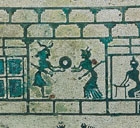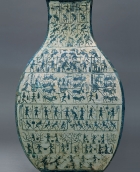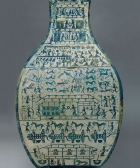J.J. Lally & Co., Oriental Art / New York City, New York
MenuPast Exhibition
Arts of Ancient China
March 27 - April 12, 2006
11.
A LARGE ARCHAIC BRONZE WINE JAR WITH
PICTORIAL DECORATION (FANGHU)
Eastern Zhou Dynasty, Warring States period,
5th-4th Century B.C.
of square section with swelling sides, cast with profile figures and animals all silhouetted in flat relief, arranged in two distinct groups of narrative scenes which are repeated on contiguous sides of the vessel, the main components of the first panel including battle scenes in the upper registers with rows of warriors wielding spears attacking rows of soldiers with shields and ge halberds accompanied by two pairs of archers, and with a central pair of fighting figures guarded by soldiers holding ge halberds and with shields at their feet, the central registers showing warriors in chariots accompanied by foot soldiers, above confronted war canoes with dragonhead prows, each with two levels, showing armed oarsmen on the lower deck and battling warriors wearing different headdresses on the upper deck, the lower registers with a lively scene of women harvesting mulberry leaves in a ritual manner accompanied by dancers and musicians, the main components of the second panel including figures drinking wine and offering toasts at ritual banquets in a three-story building shown in cross-section, above a scene of musicians playing chimes and bells on long racks supported by large birds and with other musicians playing sheng mouth organs and a jiaogu drum, beside two rows of dancers and a set of five ding-form tripod food vessels, the central register with a hunting scene including archers in horse-drawn chariots and other hunters on foot pursuing deer, a bull and a tiger, above an audience scene in a wide palatial structure guarded by soldiers and with tribute figures approaching on either side, the central hall with two figures exchanging a large jade disc, the lower registers with a row of warriors leading riderless horses above the displayed carcasses of four large tigers, each with a cauldron beneath it, above a two-story structure with three suits of armor displayed on a rack above two kneeling figures in one chamber facing a tiger in the opposite chamber, and with massive basins with ladles on either side, the square foot of the vessel edged with pairs of isosceles triangles aligned point-to-point, the handles of the vessel cast as large flat rings suspended from fluted loops, the bronze surface unevenly corroded and showing various tones of green patina shading to blue-green in many areas, in contrast to the inlaid ground which has degraded to pale tan color.
Height 17 1⁄2 inches (44.5 cm)
A very similar bronze fanghu decorated in the same style and technique in the Rietberg Museum is illustrated in the Museum Rietberg Zurich Museum Guide, Zurich, 2000, p. 75, fig. 59.
A fanghu of this type and style with pictorial decoration in flat relief restricted to three horizontal registers, now without any of the background inlay material remaining, in the National Palace Museum, is illustrated in Catalogue of the Special Exhibition of Shang and Chou Dynasty Bronze Wine Vessels, National Palace Museum, Taipei, 1989, p. 217, plate 77. A third, smaller fanghu decorated in the same technique with silhouetted figures and animals in flat relief shown in various hunting scenes, also now lacking the inlay material which filled the background, in the Freer Gallery of Art, is illustrated by Lawton in Chinese Art of the Warring States Period, Change and Continuity 480-222 B.C., Washington D.C., 1982, p. 33, no. 5.
Compare also the small fanghu on high pedestal foot in the Asian Art Museum of San Francisco, cast in the same technique with very similar scenes of battle, hunting and mulberry leaf harvesting, but now without any background inlay material, illustrated by Weber in “Chinese Pictorial Vessels of the Late Chou Period,” Artibus Asiae Vol. XXIX: 2/3, 1967, fig. 45:d.
東周 青銅宴樂狩獵水陸攻戰採桑紋方壺 高 44.5 厘米


